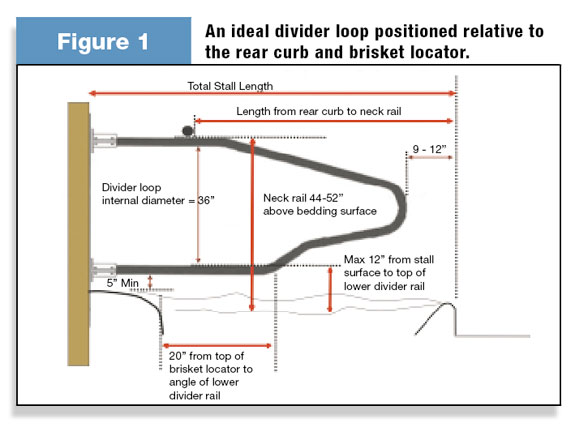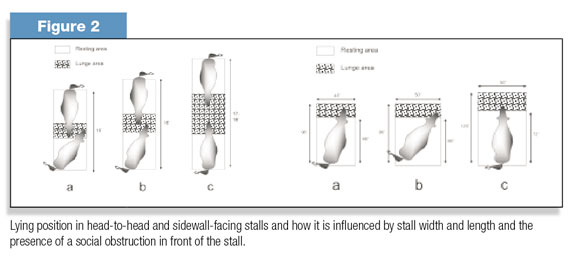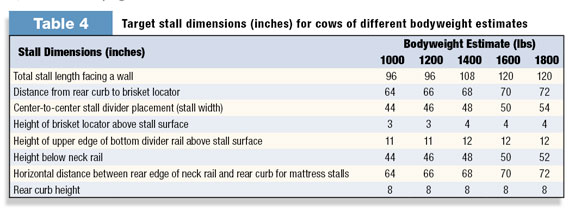In a previous article, Nigel Cook discussed the impact of inadequate rest on cows and stall surfaces. Click here to read the first part. This article will review some specifics in freestall design.
In this article, I will attempt to summarize the aspects of freestall design that are failing the cow and justify the solutions we have found and the current trends emerging in the dairy industry of the Upper Midwest. The challenge presented is to find the balance between excellent cow comfort and manageable cow cleanliness.
Providing adequate width
The freestall barns built throughout the expansion era have typically had resting spaces defined laterally by divider loops located at 43 to 46 inches (109 to 117 cm) on center, and by a brisket board typically 66 inches (168 cm) from the rear curb.
While we believe these dimensions are appropriate for a 1,200-lb (545 kg) first-lactation heifer, we believe they are inadequate for larger mature cows. The evidence for such an opinion comes from three sources.
Firstly, direct observation. Anderson examined the ergonomics of stall design and showed how limited resting space increased the disturbances between neighbors and led to more restless lying behavior.
Secondly, behavioral studies. The stall behavior studies described by Tucker et. al. used 15 Holstein cows averaging ~1,600 lbs (727 kg) bodyweight and showed a significant increase in resting time between 44-inch-wide (112 cm) and 48-inch-wide (122 cm) stalls, but no difference between 48 inches (122 cm) and 52 inches (132 cm), proving that width does have a significant effect on lying behavior and supporting wider dimensions than the industry standard of ~45 inches (114 cm).
Thirdly, herd performance changes after stall remodeling. We have remodeled a large number of freestall facilities in the Upper Midwest over the last five years and my experience has been that, after stall surface changes, increased stall width for large mature Holstein cows has been the second- most important change made in both sand and mattress facilities.
There is a commonly held belief that if we make the stall wider and longer, it will lead to increased manure contamination of the stall, inappropriate stall use behavior (eg. backwards lying) and worsening udder health. If the stall is not sized appropriate for the size of the animals using them and if the resting area is poorly defined, these concerns may well be realized.
It is therefore important to determine the size of the animals using the pen and to design the resting space correctly. Problems do occur when mixed age groups are penned together.
While small heifers in larger stalls may well soil the platform more, it makes no sense to punish two-thirds of a pen of mature cows to make sure the stalls are kept clean for the heifers. A compromise must be reached – either with stall dimensions or cow grouping strategy.
Diagonal lying is a complex behavioral issue resulting from a variety of stall design faults, but stall width is often blamed. I believe the most significant issues leading to diagonal lying are unrelated to stall width – they include adjacent cows in head-to-head stalls, too short a resting space length, brisket locators that are too high, inadequate lunge space, head bob restrictions and neck rails too close to the rear curb.
Failure to understand these causative factors results in poorly designed stalls where cows become contaminated with manure. Therefore, we need to make sure the resting area is correctly defined, so manure contamination of the bed can be minimized.
Defining the resting area
The stall resting space is defined laterally by the divider loop and in front by the brisket locator. We need to provide just enough direction to align the cow correctly in the stall but not inhibit the boundaries of the area so much that lying and rising behavior has to be modified to the point that it reduces the ability of the cow to use the stall.

For these reasons, we prefer a divider loop that has the following characteristics ( Figure 1, page 79 ):
1. Locates the upper edge of the lower divider rail at 12 inches (30 cm) above the stall surface. This serves to align the cow, enables the cow to lunge easily to the side over the top of the rail if she chooses to do so and is high enough to reduce trauma to the front leg below the rail and limit cows putting their legs through the loop.
2. Has an angle in the lower rail located 20 inches (51 cm) behind a correctly located brisket locator. This location serves to align the cow but limits trauma to the hip area.
3. Has an interior loop diameter of 35 inches (89 cm), or exterior diameter of 39 inches (99 cm). This will make sure that with the lower rail correctly located, the upper rail will place the neckrail at around 50 inches (127 cm) above the stall surface.
The resting space is defined in front by the brisket locator, which serves to position the cow when she is resting, so her rear end is adjacent to the alleyway to reduce soiling of the bedding.
Behavioral studies have shown that cows prefer to lie in stalls without a brisket locator, compared to stalls with an eight-inch-high (20 cm) piece of wood. Many consultants have taken this to mean we should build stalls without brisket locators. This is a mistake.
While I will concede that in a short stall – less than 8 feet (2.44 m) – a poorly designed brisket locator can be removed resulting in an observable improvement in stall usage, larger stalls require a locator to help position the cow.
The problem with brisket locator design is the movement of the cow’s front leg when rising in the stall. To facilitate rising, she needs to take a full forward stride and it is difficult for most cows to lift their leg much higher than about four inches (10 cm) above the stall surface.
Generally, we have moved away from the traditional brisket board (a wooden form used to pour the concrete curb), to more rounded plastic, fiberglass or PVC pipes or mouldings. These have performed reasonably well, but because they are lower, smoother and less restrictive, some cows choose to ignore them.
Because of these issues, we have returned to concrete for the answer and I have developed a design that we call the “brisket slope.” This serves to locate the cow, while being low enough to allow the cow to lie down with her front legs outstretched and sloped enough to allow the front leg to land on the slope when rising.
Providing adequate lunge and bob space
When the cow rises, she moves her head forward in a lunging motion to take the weight off her rear legs, to facilitate rising. The head is lowered, almost to the surface she is resting on and then “bobs” upward.
We refer to the horizontal area in front of the resting space as lunge space and the vertical area at the end of the lunge as the bob zone.
Failure to provide adequate lunge and bob space may not result in a dramatic reduction in stall occupancy, but it does alter the way cows use the stalls in subtle ways. Tucker et. al. found no effect on lying times for ~1600-lb (727 kg) cows housed in stalls 90 inches (2.29 m) long or 108 inches (2.74 m) long. There are three possible reasons for this:
1. It doesn’t matter
2. Neither of the choices were long enough for front lunge – our recommendation is for cows weighing ~1600 lbs (727 kg) to be housed in stalls 120 inches (3.05 m) long –
3. The cows could side lunge because the lower divider loop rail was correctly located to allow this option
I believe that 2 and/or 3 are the most likely explanations.
Having seen the results of numerous barns that have extended side walls to allow 9.5 to 10 feet (~3.0 m) long side wall stalls, I am convinced it does make a difference, especially for the largest, oldest cows on the farm. I am also convinced some cows will want to side lunge, and we should allow that as an option.
This is particularly true of head-to-head stalls. The presence of one cow in front of another adds an element of uncertainty in stall design, in that some cows will not lie straight or lunge into a cow facing her. This leads to diagonal lying and side lunging. This also has an effect on how clean the stalls are if we change stall dimensions.

In order to maximize width, without running into diagonal lying issues, we must provide adequate length for front lunge. For mature Holstein cows that means stalls that are 10 feet (3.05 m) long facing a wall and at least 17 feet (5.18 m) head-to-head ( Figure 2 ).
Locating the neck rail
The neck rail serves to provide lateral stability to the divider loops while helping to position the cow while standing in the stall relative to the rear curb. It is important to realize the cow on pasture rises and ends up standing two to three feet (60-90 cm) in front of where she was lying.
Therefore, wherever we place the neck rail, it will be in the way of the cow – even if it is “floating” or is made of some material other than metal. The trick is to locate it so that the cow can cope and adjust and take a step backward, rather than a step forward when she rises.
Neck rails do not influence lying time much, but they do influence standing behavior when located between 55 inches (140 cm) and 92 inches (234 cm) from the rear curb and between 40 inches (102 cm) and 50 inches (127 cm) above the stall surface, with lower rails closer to the rear curb increasing the amount of perching (standing half-in and half-out of the stall) observed. We associate these neck rail locations with a greater risk for injury also.
Neck rails located too far forward increase soiling of the stall bed and frequently farmers respond by moving the rail back closer to the curb. However, if there is insufficient space to rise comfortably below and behind the neck rail, cows have difficulty standing without hitting the rail – which is just unacceptable.
While a contaminated stall may be a risk for udder infection, an unused stall is most definitely a risk for inadequate rest, lameness problems and early herd removal. We therefore have to find the right balance between comfort and cleanliness.
Neck rail location recommendations are different in mattress and sand stalls because the raised rear curb modifies the way cows stand in the stall – they are reluctant to stand on a raised concrete curb.
Neck rails are located in mattress stalls directly above the correctly located brisket locator – so the cow is able to stand squarely in the stall, but in deep bedded stalls with a raised rear curb, where the neck rail is at least 48 inches (122 cm) above the surface, we move the rail back a distance equivalent to the width of the rear curb, so the cow takes a step back and perches half-in and half-out of the stall.
While we will not tolerate this behavior in a flat, mattress stall, we are prepared to tolerate it in a deep, loose-bedded stall, because the front foot elevation is much less and the problems of managing a deep bed soiled with urine and feces are too great.
While there is some evidence to suggest extended time perching increases the risk for lameness, this does not seem to be a factor in sand stalls as 90 percent of the stall standing behavior is perching and lameness prevalence is almost half of that on mattresses. This probably relates to the fact that stall standing time is about half in sand stalls compared with mattress stalls.

Conclusion
I believe that stall designs which were commonplace in freestall barns up until a few years ago are failing the cow and our industry in terms of performance, health and well-being. We can and should do better ( Table 4 ), and it is economic to do so. Numerous barn renovations have proven this to be the case.
However, doing what is right for the cow is not solely an economic question. Welfare has never been and never will be an argument based on economics. It is a duty that transcends such discussion. Fortunately, the balance of welfare and economics are in alignment when we consider improvements to cow comfort.
It is true to say that when we make stalls bigger, there is greater risk for design error, leading to diagonal lying and manure contamination of the stall bed. However, it is also true that a “one-size-fits-all” policy of restraint has also failed.
In this discussion, I have detailed the common errors made when making stalls bigger – using the wrong divider loop, not using a brisket locator or using a poorly designed one, failing to understand the importance of forward lunge and bob space to lying position and locating the neck rail incorrectly.
Such problems are common because builders and farmers have not built such large stalls before and there is much confusing misinformation about new design philosophies. Hopefully, this article has put some of these issues to rest. PD
References omitted due to space but are available upon request to editor@progressivedairy.com .
Nigel B. Cook
Clinical Assistant Professor
University of Wisconsin
nbcook@wisc.edu







